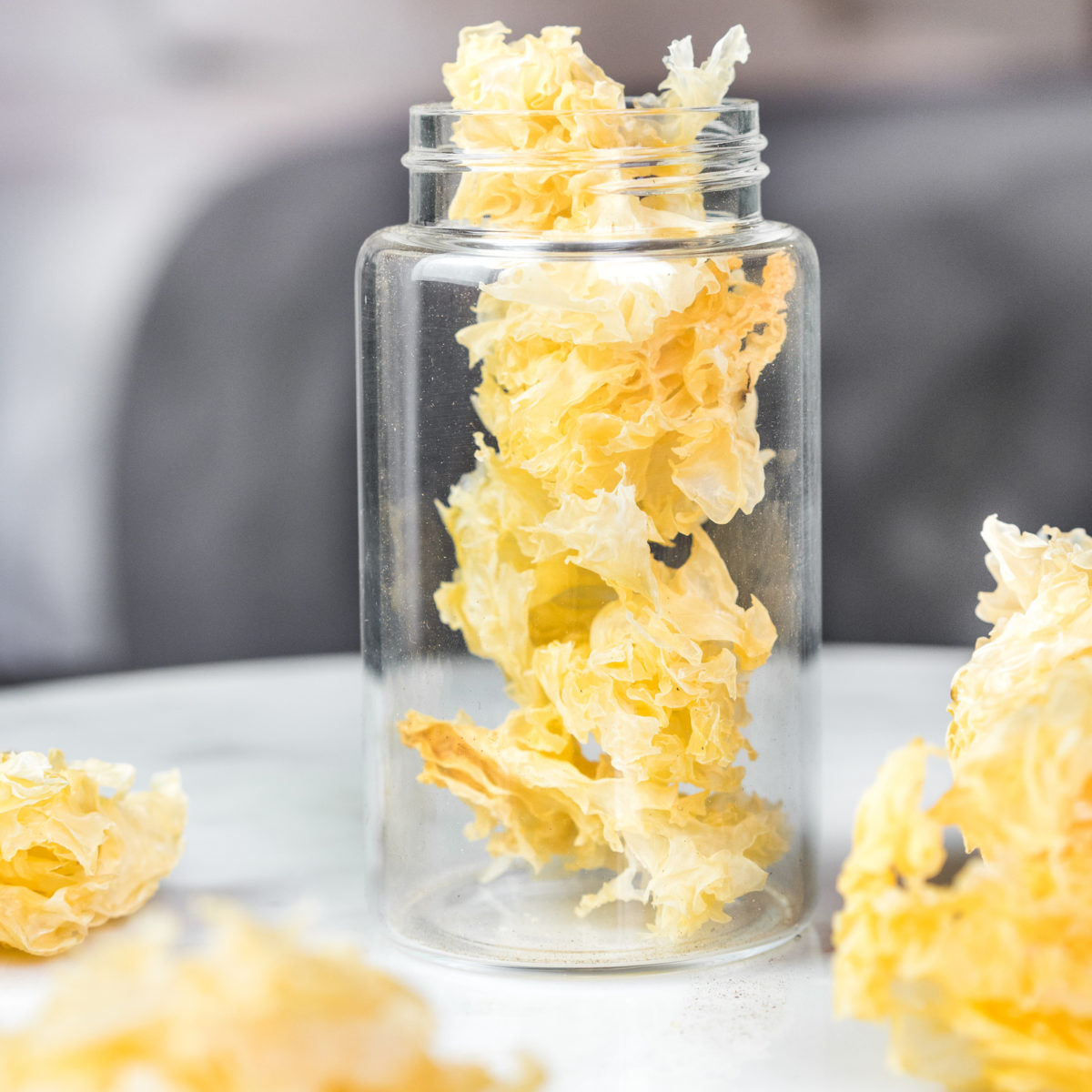
COMMON NAME (Chinese Name)
White Wood Ear (Bai Mu Er)
BOTANICAL NAME
Tremella Fuciformis
COMMON NAME
White Wood Ear; White Fungus; Snow Fungus; Trememella; Beauty Mushroom
USES
Many different research studies have reported (and confirmed) the potential effectiveness of white wood ear mushroom derivatives as anti-inflammatory, anti-aging, and antioxidant treatments. The antioxidant and anti-inflammatory properties of white wood ear extract have received special attention from researchers, as they have the most significant topical and oral applications in both daily life and novel medicinal treatments.
Most significantly, white wood ear derivatives show huge promise for use as topical anti-aging and age-repairing treatments for UV-damaged (photoaged) and oxidation-damaged skin. In each of these cases, extracts made from white wood ear mushrooms show significant potential (in human trials) for protecting skin against sun damage and naturally-produced signs of aging. Moreover, though it has not yet been proven in human clinical trials, topical white wood ear extract applications show promise for use moisturizing and maintaining the hydration of skin cells. Studies of cosmetic products containing these extracts have shown that this moisturizing potential may be at least as good as (if not better than) that of popular hyaluronic acid products.
The combined effect of these activities is that topical use of white wood ear extracts improves skin elasticity/flexibility, minimizes and prevents against the formation of wrinkles, and improves overall skin texture.
White wood ear, or Tremella, is a food grade fungus classified in Chinese medicine as a Yin tonic. It is sweet, bland and neutral and affects the Lung and Stomach channels.
PREPARATION & ADMINISTRATION
Some of the most common preparations of white wood ear mushrooms include making tonics and extracts from the sliced, dried, and decocted mushrooms themselves. Some herbal supplement suppliers may also carry white wood ear mushroom powder and/or pills. That said, these forms are likely to be less bioavailable either via digestion or skin absorption than long-cooked extracts and other water-based and alcohol-based tinctures. White wood ear mushroom extracts are also a common ingredient in commercial skincare creams.
PRECAUTIONS
There are no reported side-effects of white wood ear mushroom supplementation, either in animal studies or human clinical trials. Nevertheless, you should consult with a certified herbalist, physician or other qualified healthcare professional before taking white wood ear. You should be aware of the potential for allergic reactions and observant of changes in physical health that may be associated with their use.
REFERENCES
Lai, et al. “Optimization of Extraction Technology of Polysaccharide from Tremella Fuciformis on Commercialized Basis and Its Function in Skin Care Cosmetics.” China Surfactant Detergent & Cosmetics, vol. 04, 2010.
Li, H., Lee, H.‐S., Kim, S.‐H., Moon, B. and Lee, C. (2014), Antioxidant and Anti‐inflammatory Activities of Methanol Extracts of Tremella fuciformis and Its Major Phenolic Acids. Journal of Food Science, 79: C460-C468. doi:10.1111/1750-3841.12393
Liu. “Http://En.cnki.com.cn/Article_en/CJFDTotal-AHNY201226130.Htm.” Journal of Anhui Agricultural Sciences, vol. 2, 2012.
PROGRESS IN MOLECULAR BIOLOGY AND TRANSLATIONAL SCIENCE: Glycans and Glycosaminoglycans as … Clinical Biomarkers and Therapeutics Part b. ELSEVIER ACADEMIC Press, 2019.
Ruan, Yang, et al. “Tremella Fuciformis Polysaccharides Attenuate Oxidative Stress and Inflammation in Macrophages through MiR-155.” Analytical Cellular Pathology, vol. 2018, 2018, pp. 1–10., doi:10.1155/2018/5762371.Wu,
Shen, Tao, et al. “Tremella Fuciformis Polysaccharide Suppresses Hydrogen Peroxide-Triggered Injury of Human Skin Fibroblasts via Upregulation of SIRT1.” Molecular Medicine Reports, vol. 16, no. 2, 2017, pp. 1340–1346., doi:10.3892/mmr.2017.6754.
Wang, Xiaomei, et al. “Carboxymethylation of Polysaccharides from Tremella Fuciformis for Antioxidant and Moisture-Preserving Activities.” International Journal of Biological Macromolecules, vol. 72, 2015, pp. 526–530., doi:10.1016/j.ijbiomac.2014.08.045.
W. Xu et al., “Protective Effect of Polysaccharides Isolated from Tremella fuciformis against Radiation-induced Damage in Mice,” in Journal of Radiation Research, vol. 53, no. 3, pp. 353-360, May 2012.
Wen, Lingrong, et al. “Effect of Polysaccharides from Tremella Fuciformis on UV-Induced Photoaging.” Journal of Functional Foods, vol. 20, 2016, pp. 400–410., doi:10.1016/j.jff.2015.11.014.
Yu-Ji, et al. “Structure, Bioactivities and Applications of the Polysaccharides from Tremella Fuciformis Mushroom: A Review.” International Journal of Biological Macromolecules, vol. 121, 2019, pp. 1005–1010., doi:10.1016/j.ijbiomac.2018.10.117.
